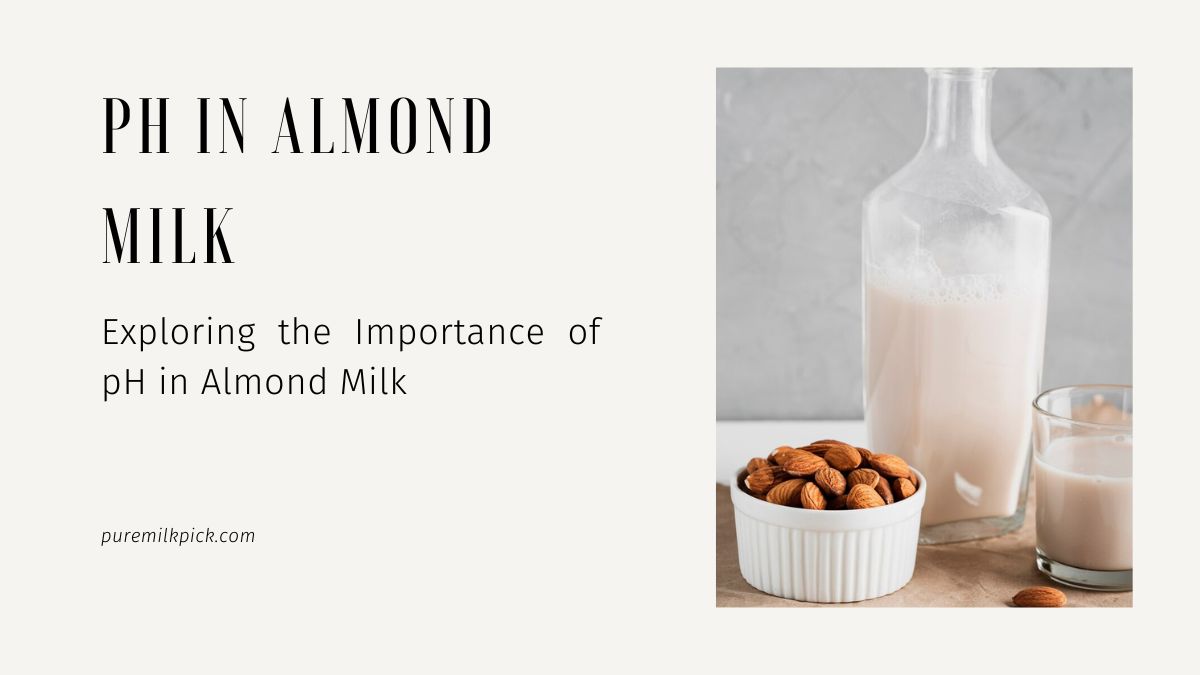Welcome to our in-depth exploration of almond milk and its pH levels! Almond milk has become increasingly popular as a dairy-free alternative, but did you know that pH plays a crucial role in its taste, texture, and overall quality? In this comprehensive guide, we’ll delve into the fascinating world of almond milk pH, from its definition and importance to its effects on flavor and production. Whether you’re a curious consumer or a budding almond milk aficionado, prepare to gain valuable insights into this essential aspect of almond milk production.
What is Almond Milk pH?
Understanding pH
pH is a measure of the acidity or alkalinity of a substance, ranging from 0 to 14 on the pH scale. A pH of 7 is considered neutral, while pH values below 7 indicate acidity, and values above 7 indicate alkalinity. In the context of almond milk, pH plays a critical role in determining its taste, texture, and overall quality.
Introduction to Almond Milk pH
Almond milk pH refers to the level of acidity or alkalinity present in almond milk. Like other food and beverage products, almond milk has an optimal pH range that contributes to its sensory attributes and shelf stability. Understanding and controlling the pH of almond milk is essential for ensuring consistency in flavor, texture, and nutritional content.
Read More: Crafting the Perfect Sugar Cookie Frappuccino: A Delicious Guide
Importance of pH in Food and Beverage Products
pH is a fundamental aspect of food science and plays a crucial role in various food and beverage products. It influences factors such as flavor, texture, microbial stability, and shelf life. By monitoring and adjusting pH levels, food manufacturers can achieve desired sensory attributes and ensure product safety and quality.
pH Levels in Commercial Almond Milk
pH Range of Commercially Available Almond Milk
Commercial almond milk typically has a pH range between 6.5 and 7.5, making it slightly acidic to neutral. However, pH levels may vary depending on factors such as processing methods, ingredient quality, and formulation variations among brands.
Factors Influencing pH Levels in Commercial Almond Milk
Several factors can influence the pH levels of commercial almond milk, including the quality of almonds used, the presence of additives or stabilizers, processing techniques such as pasteurization, and packaging materials. Each of these factors can impact the acidity or alkalinity of the final product.
Impact of pH on the Taste and Texture of Almond Milk
pH plays a significant role in determining the taste and texture of almond milk. Optimal pH levels contribute to a balanced flavor profile, with a mild sweetness and nutty undertones. Additionally, pH affects the viscosity and mouthfeel of almond milk, influencing its texture and overall sensory experience.

Effects of pH on Almond Milk
Influence of pH on Flavor Profile
The pH of almond milk directly influences its flavor profile, with deviations from the optimal range potentially resulting in off-flavors or sourness. By maintaining the ideal pH level, manufacturers can achieve a smooth and pleasant taste that appeals to consumers.
Impact of pH on Stability and Shelf Life
pH also plays a crucial role in the stability and shelf life of almond milk. Optimal pH levels help to inhibit the growth of spoilage microorganisms and extend the product’s freshness. However, fluctuations in pH can compromise the shelf stability of almond milk, leading to spoilage and quality deterioration over time.
Relationship between pH and Texture of Almond Milk
The pH of almond milk influences its texture and mouthfeel, with variations in acidity or alkalinity affecting viscosity and consistency. Almond milk with the correct pH level exhibits a smooth and creamy texture, enhancing its appeal to consumers. However, deviations from the optimal pH range can result in undesirable texture changes, such as curdling or separation.
pH Adjustment in Almond Milk Production
Methods for Adjusting pH in Almond Milk
During almond milk production, manufacturers may employ various methods to adjust pH levels and achieve the desired sensory attributes and shelf stability. Common pH-adjusting agents include food-grade acids or bases, such as citric acid or sodium hydroxide, which are added in controlled amounts to achieve the target pH range.
Role of pH Regulators and Stabilizers
pH regulators and stabilizers play a crucial role in maintaining the pH of almond milk within the optimal range throughout production and storage. These additives help to control acidity or alkalinity, prevent pH fluctuations, and ensure product consistency and quality.
Considerations for pH Adjustment in Almond Milk Formulation
When formulating almond milk, manufacturers must consider various factors that can affect pH levels, such as ingredient quality, processing conditions, and packaging materials. By carefully controlling these variables and monitoring pH throughout the production process, manufacturers can produce high-quality almond milk with consistent sensory attributes and shelf stability.

Tips for Home Almond Milk Production
pH Testing Kits for Homemade Almond Milk
For those interested in making almond milk at home, pH testing kits are available to measure the acidity or alkalinity of the final product. These kits typically include pH strips or meters that provide accurate readings, allowing home cooks to monitor and adjust pH levels as needed for optimal taste and quality.
Factors to Consider for Achieving Optimal pH in Homemade Almond Milk
When making almond milk at home, it’s essential to consider factors that can influence pH levels, such as the quality of almonds used, water purity, and the presence of additives or flavorings. By using high-quality ingredients and following proper techniques, home cooks can achieve almond milk with a balanced pH and delicious flavor.
Importance of Hygiene and Sanitation in Home Almond Milk Production
Maintaining proper hygiene and sanitation practices is crucial when making almond milk at home to prevent contamination and ensure food safety. Cleanliness extends to equipment, utensils, and work surfaces, as well as hands and packaging materials. By following hygienic practices, home cooks can produce almond milk that is safe to consume and free from harmful pathogens.
Conclusion
In conclusion, pH plays a vital role in the taste, texture, and overall quality of almond milk. By understanding the importance of pH in almond milk production and its effects on sensory attributes and shelf stability, consumers and manufacturers alike can appreciate the significance of this fundamental aspect of food science. Whether enjoying commercial almond milk or crafting homemade varieties, maintaining optimal pH levels ensures a satisfying and delicious almond milk experience.
Frequently Asked Questions
The ideal pH range for almond milk is typically between 6.5 and 7.5, making it slightly acidic to neutral. This range contributes to a balanced flavor profile and ensures product stability and shelf life.
To adjust the pH of homemade almond milk, you can use food-grade acids or bases, such as lemon juice or baking soda, in controlled amounts. Adding these ingredients gradually while monitoring pH levels allows you to achieve the desired acidity or alkalinity.
While pH does not directly affect the nutritional composition of almond milk, maintaining optimal pH levels is essential for preserving the product’s quality and freshness. Deviations from the ideal pH range can impact flavor, texture, and shelf stability but do not significantly alter the nutritional content.



